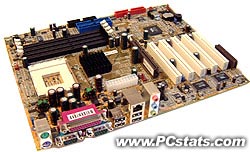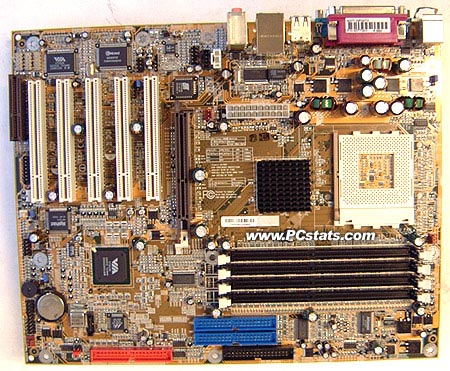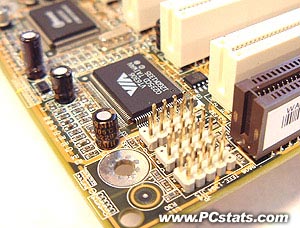DFI AD77 Infinity KT400 AMD Motherboard
 In the latter half of 2002, AMD
really slowed down in terms of technology advancement - chip release slowed, and even
motherboards supporting AMD processors seemed to be all but forgotten. This slowdown was mainly
due to AMD's 0.13 micron manufacturing and supply problems, but things seemed to
come to a halt.
In the latter half of 2002, AMD
really slowed down in terms of technology advancement - chip release slowed, and even
motherboards supporting AMD processors seemed to be all but forgotten. This slowdown was mainly
due to AMD's 0.13 micron manufacturing and supply problems, but things seemed to
come to a halt.
Now that AMD has solved their initial teething
problems with 0.13, the future for them and their partners seems a lot brighter.
Barton is just around the corner and AMD's long awaited Hammer line of
processors will finally debut sometime in the spring of 2003, possibly even as
early as March.
Today we're going to check out DFI's latest KT400 based motherboard; the AD77
Infinity. The AD77 Infinity has all sorts of "goodies" such as Serial ATA, USB
2.0, IEEE 1394, 10/100 LAN, 5.1 audio and 8x AGP.
If that's not enough for you, there are four DIMM slots which support
up to 4 GB of either PC1600/2100/2700/3200* (* - PC3200 support is unofficial) and
five PCI slots should you need to install more devices. DFI have also included the ever
useless CNR slot, which is mainly for OEM's. Lastly, the DFI AD77 has support
for any current AMD Athlon/XP 200/266 or 333 MHz processor.
| dfi ad77
infinity |
 |
Ships with the following:
- 2x IDE ATA66/100 Cable
- Serial ATA Cable
- FDD Cable
- Driver CD
- RAID Driver Disk
- User Manual
- RAID Manual
- USB 2.0 Bracket
- IEEE 1394 Bracket
- Game Port Bracket
- I/O Back Panel Bracket
|
As you can see, the AD77 Infinity is quite plain looking
- DFI were never into any fancy coloured PCB's, they know that
performance and stability are far more important then
flash.
The layout of the AD77 Infinity is very good, the main IDE
and floppy connectors are in the most ideal location to the right of the DIMM
slots. Even the extra IDE connector will not get in the way of most consumer PCI
devices.

The AD77 Infinity Up Close and
Personal
Like only a very few number of manufacturers
out there, DFI places all the connectors (USB, IEEE 1394 and the game port)
at the bottom of the motherboard. This is extremely helpful in keeping the
cables away from the other system devices.
We're impressed
by how well the "little things" are done right with the AD77 Infinity. The
board is very well labelled, you not have to refer to the manual
when setting up or installing any devices.
If you don't know what a certain jumper does, DFI will have an explanation somewhere on
the PCB. All three fan headers are easily accessible and with more and more
people using third party GPU coolers, it's nice to see DFI place a
fan header just above the AGP slot.
It was nice to see that DFI took some extra care around the CPU socket. Under
the CPU retention clips are pieces of plastic that shield the PCB on both
sides. With clipping heatsinks require more and more pressure to install them,
this ensures that you don't damage the motherboard when installing the
heatsink.
DFI also included a four diagnostic LED's. This seems to work very similar to
MSI's DLED and works on the same concept as a Port 80 card. Unfortunately DFI
forgot to include the necessary information to decipher the codes. After a
bit of use though, you'll get an idea of what they mean though. While this is a
good step in the right direction, we would have prefer DFI just use a Port 80
card instead.

